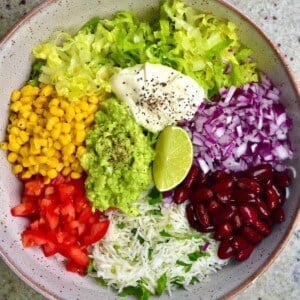Bibimbap is a Korean rice bowl dish that combines stir-fried rice with loads of veggies, umami mushrooms, and protein toppings. This quick vegetarian version is my favorite because I can use any leftover vegetables from the fridge and day-old rice. Below, I am sharing my top choices for add-ins, but you can easily customize the recipe to use what you have at hand. Plus, while I mostly make mine meatless, you could top your bowls with chicken or beef (like this Korean bulgogi beef).
How to make bibimbap
Prepare the rice: I usually make the recipe with leftover rice. If you don’t have any, cook short-grain rice first and let it steam in the pot while preparing the rest of the ingredients. Prepare Vegetables: You can prep them in any order you like. This is how I proceed with the recipe. First, sautee the spinach in a dry skillet at low heat. When it wilts and becomes soft (it takes about 1 minute), season with a splash of sesame oil and tamari for extra flavor. Next, shred the carrots using a julienne peeler or a grater, and then lightly sauté them in sesame oil over medium heat until softened (another 1-2 minutes). Set them aside. Thinly slice the cucumber and marinate it in a small bowl with rice vinegar and sesame oil for a tangy, nutty flavor. In the meantime, heat a small pot of water and blanch the bean sprouts for 1 minute, then drain. This will add a delicious crunch to the dish. Slice the mushrooms and sauté them in a dry pan. Once they release their water, add the butter and a splash of tamari and rice vinegar and stir fry them for 1-2 minutes to enhance their rich umami flavor. Fry one egg per person with a bit of vegetable oil—cook for 3-4 minutes to achieve your perfect sunny-side-up eggs. Finally, in a small bowl, make gochujang sauce by whisking the gochujang paste with maple syrup, sesame oil, and rice vinegar. Chop the scallions so they are ready for garnish. Assemble the Bowls: Layer the rice, mushrooms, cucumbers, bean sprouts, carrots, and spinach in individual bowls. Then top with the fried eggs. Drizzle with gochujang sauce to taste and sprinkle with the chopped scallions and sesame seeds. Serve with kimchi on the side and extra sauce or your favorite side dishes. Enjoy! If you try this dolsot bibimbap recipe, let me know how it goes in the comments below. I’d appreciate a recipe card rating and would love to see your recipe recreations – tag me on Instagram @Alphafoodie!







